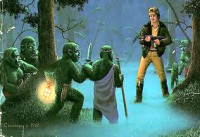Idealized Humanity and its Others:
Equality in The Word for World is Forest
By Su İpek Özbek and Ulaş Ersezen

The Word for World is Forest by Ursula K. LeGuin (1972) is a provocative work of science fiction that deals with the concepts of humanity, class, gender inequality, racism, and colonialism in an explicit but innovative manner. These ideas are presented by their association to the overwhelmingly anthropocentric fabric of our society today. The text displays how anthropocentrism breeds inequality and disharmony and inspires readers to think about what true equality really means.
The dark green world of the Athsheans is introduced to the reader with the name “New Tahiti”. New Tahiti is a colony of Earth, and Athsheans are called creechies by their supposed Earthling superiors, the Terran people. Ape-like in appearance, the Athsheans are sensitive, highly intelligent people whose culture has developed around the importance of non-violence and self-regulation. Males and females, while segregated in some areas, have their own autonomy and authority regarding everything that has to do with their government. Their existence is one with the environment and they show respect to nature as much as they do to other members of their community. They fight and win battles by singing to each other, physically on top of their opponent. However, the Atshean people and their non-violent ways are forever changed after the Terrans set foot on their world.
The first chapter focuses on the perspective and experience of Captain Davidson who is in charge of Smith Camp. At first, the reader is meant to think that the creechies are sub-human, and millions of years away from gaining a level of consciousness higher than that of beasts. They are treated like animals; overworked, abused, and raped by men despite the rules stating otherwise. Davidson states that these creatures are not in fact human, and he believes that everything should be aimed at the betterment of humanity. Likewise, Earth’s supply of trees has been completely depleted, and now the Terrans have come to harvest from the Athshean land. Similar to the mistreatment of Athsheans, women are brought to the colony as livestock for the men. Very soon into the novel, we see the representation of the real-life equalization of women and people of color with nature as things to be overcome, used, or tamed. This equalization results in the degradation and exploitation of all – women, people of color and nature, for the pleasure and power of Davidson: a not-so-subtle figure who symbolizes the white western patriarchal structure that has made a significant mark on the world. Davidson’s supposedly noble efforts for humanity are exactly what fuels his hate. In his human-centric view of order, humanity is synonymous with man understood to be male and everything that is outside of this identity falls into the category of ‘wild nature’. Davidson keeps repeating the idea that nature should be tamed. Women are tamed, the non-violent Athsheans are tamed: just like animals, forests, emotions, poetic urges. The Judeo-Christian idealization of man is influential in this tradition of exalting manhood synonymously with humanity and therefore creating an unsafe societal environment for any and every being left out of this description. The text clearly displays the need for equality as well as the need for the reimagining of what humanity is and questions the validity of our divisive systems of categorization and devaluation of “other” beings.

